#queer asian american history
Text
Brb going to cry about this photo for the rest of my life
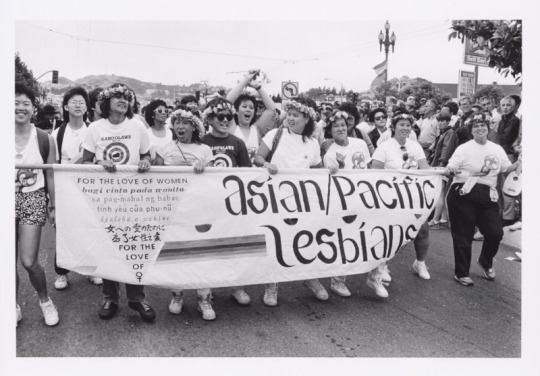
#asian american pacific islander heritage month#queer asian#queer asian american history#its the sa pag-mahal ng babae that really sent me#pride#lesbian#gay
75 notes
·
View notes
Text


Katsushika Hokusai, South Wind, Clear Sky, 1830
Andy Warhol, Vesuvius, 1985
#katsushika hokusai#andy warhol#mount fuji#fuji#vesuvius#volcano#landscape#pop artist#pop art#japanese prints#japanese art#japanese artist#asian art#american artist#american painter#queer art history#queer artist#woodcut#woodblock print#silk screen#modern art#art history#aesthetictumblr#tumblraesthetic#tumblrpic#tumblrpictures#tumblr art#aesthetic#beauty
88 notes
·
View notes
Text
This Easter and TDOV really just showed that people have a lot of shit to say but don't know what the everloving fuck they're talking about.
"Why do Trans people need a day you have a whole month already???" Trans Visibility Day is for Trans people, Pride month is for all Queer people. It's different. But also there are other national months that have a dedicated day in a different month.
Easter is a different day every year and sometimes it's going to land on a day that already has a holiday/nationally recognized day. You gonna be mad at stoners next year for daring to have a smoke with jesus?
Why do you think February is Black History Month? Or why May is AAPI month? Or why June is Pride month?
Do people think that national months happen by closing our eyes and pointing at a calendar? Do you think we just picked a month at random and claimed it ours? Significant moments and events in history happened during those months. And it often took years for those months to be nationally recognized. History is actually so fun to learn about please read something I'm begging.
• And if you're outside of the U.S and you have different national months/holidays please let me know I'd love to read about it!
(Also I only used History.com and one AmericanBar articles because other links weren't working but I encourage you to do research from other sources as well as read the articles I linked.)
In February Black History Month was Black History week for decades:
In March Women's History Month started as Women's History Week:
April is Arab American Heritage Month:
May is Asian American & Pacific Islander Month:
June is Pride Month:
Juneteenth:
July is Disability Pride Month:
September 15 to October 15 is Hispanic Heritage Month:
Indigenous Peoples' Day is the second Monday in October, and November is Native American Heritage Month:
#history#black history month#womens history month#arab american heritage month#asian american and pacific islander month#aapi month#pride month#stonewall#disability pride month#hispanic heritage month#Indigenous peoples day#native american heritage month#punk#trans day of visibility#lgbt#lgbtqia#lgbtq#queer#trans#american history#us history#easter#juneteenth#tdov#queer history
8 notes
·
View notes
Text
also today in queer history class discussion i pitched the question "how has your race impacted your experiences as a queer person" and so one of my classmates talked abt how she was usually the only black person in queer spaces (or if not, then the only dark skinned black person) and talked a lot abt the isolation of it all
which was cool to hear, but not quite what i was looking for, so at the end i was like, "follow-up question: how has your blackness influenced your queerness?"
and after class she told me no one had ever asked her that before and so she'd never had to consider it, but now she was excited to just throw that at every other queer person of color in her life because it's like, "huh. what kind of homoeroticisms DO i experience as a result of my culture? how CAN i express my queerness in a way that also feels at home with my culture, instead of just picking an expression that is one or the other?" and i think that's beautiful. i hope she figures out how she wants to be queer in her own uniquely black way
#the worm speaks#me bringing my valuable experiences with the blending of cultures as a mixed race person to the table 2day it seems lol#and she went on to tell me how there are a lot of examples of queer black *masculinity* but very few came to mind#of like queer black *femininity* n so ultimately i'm still left not knowing what homoeroticism looks like to like.#bc she is genderfluid n so she's not a woman but she is femme and she's mentioned this many times#but like you guys get my gist#i think i brought a lot of unexpected questions to the discussion today LOL like the reading was abt the erasure of queer asian americans#in the history of the united states and yep there sure were a lot of queer asians erased but like for some reason it didn't really strike me#as a subject to discuss or ask a lot of questions about. same with the mentions of orientalism LOL#i think i'm also a little bit averse to bringing up orientalism bc i feel like i risk being accused of it myself by nature of being mixed#as if being half white is all that matters in a discussion about race as if i've never felt the pressures n hardships of being asian myself#etc etc it's a little hard for me to feel like i'm allowed to speak abt the subject lol but it was like The One Subject#the prof deliberately drew attn to towards the end to discuss#mostly i focused my questions for the class on the subjects of culture and community building and the desire for connection#stuff i'm both deeply familiar with bc of blorbo studies and also kind of asian about lol
4 notes
·
View notes
Text
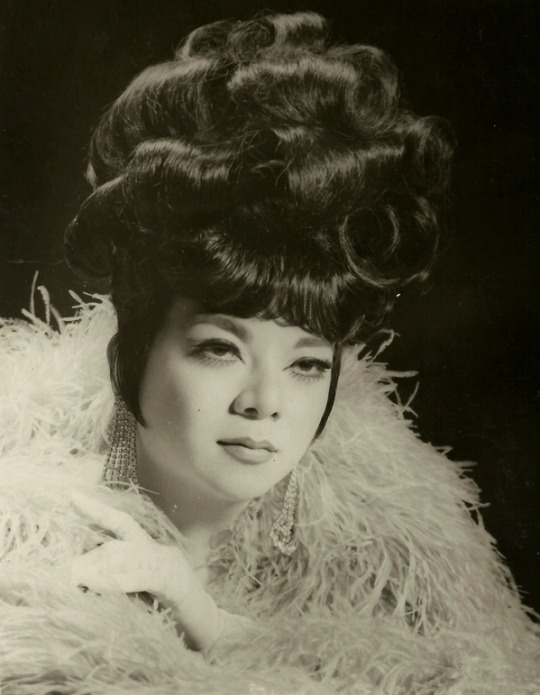


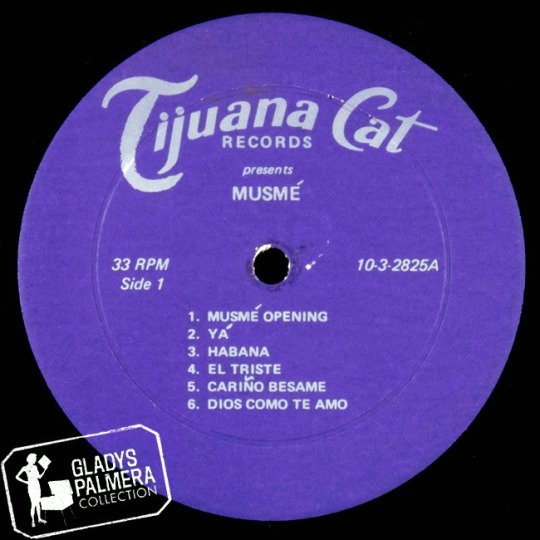
Musmé, Sino-Cuban Drag Queen and Singer
#musmé#madame musmé#cuba#china#drag queen#drag#sino cuban#chinese cuban#asian latino#queer history#gay history#transformista#trans history#queer caribbean#art#arte#queer asian#arte latinoamericano#caribbean#latin american art#caribbean art#caribbean artist#caribeño#antillano#latino artist#antillana#singer#cabaret#performance#performer
48 notes
·
View notes
Text
Probably one of the most unfortunate things about RWBY is, for all it's inclusion of characters of color, there's no real cultural identity behind any of it
Outside of names, what is there to identify Yang or Ren or Sun as Asian? Other than skin tone, what marks Emerald as a Black woman? What marks Maria as hispanic besides her surname and clothes loosely inspired by Dio de los Muertos?
The few times crwby genuinely tried to tie these things together have ended in total failure. Flynt Coal is so unambiguously Black that his weapon and design are just Jazz... and that's his entire character. The Black One to counter our White Hero for 4.2 minutes, then claim he digs her style, thus negating every relevant real-world implication of a large, wealthy white family driving small time entrepreneurs of color out of business
Every single attempt at inclusion is through such a glaringly White lens that it's no wonder that people often mistake Sun or Ironwood as white despite being named after a Chinese deity or being modeled after their Asian VA. And that's so disappointing in ways I don't think I could ever truly put into words
#rwde#idk man#im thinking abt how all my ancestors cultures have been boiled down to nothing but White and im fucking mad#i cant even imagine how it must be on the other side#my cultures were erased to appease a power structure my ancestors wanted an in to but other folks had theirs STOLEN#to have your identity stolen then repackaged to you in the most insincere way possible by idiots who think they know best#its a disgrace unlike any other#anyway this is a v long winded way of saying please let other cultures have a chance in fantasy/sci fi settings#let black characters have kinky hair and cornrows and african specific jewelry like the lip gauges and gold neck rings#let asian characters be more than aesthetics and ramen and wisdom spouting gurus#and also remember asia is a big fucking continent so theres a myriad of cultures under the Asian name w lots of history and conflict#we are well beyond the point of pinning all Asian rep on one character a la Hikari Sulu#also also remember that indigenous people EXIST#and they exist beyond bandit stereotypes or as nObLe SaVaGeS#also middle eastern folks could def use some rep beyond evil terrorists and helpless victims in need of rescue (by americans!!1!)#this doesnt even cover shit like religious or disabled or queer cultures- all of which have rich complicated histories that affect today#there are so many things to consider when building a world from scratch and they did absolutely NOTHING AHHHHHHHHH
24 notes
·
View notes
Text
What A Civil War Is And Is Not
The idea for this particular episode was inspired by what’s going on over here in the United States. As I’m sure everyone knows, we had a coup attempt in January and there was a lot of talk of a new civil war and a lot of the traitorous morons who took part in the Jan 6th insurrection claimed they’re looking forward to a civil war and all that crap. And it got me thinking that even though we’re talking about the next civil war, we’re not actually talking about civil wars. What does a civil war mean? What do modern civil wars look like? Etc.
I will warn my listeners that I was an international relations major before I was a historian, so we will be discussing political theory during this blog post, but I’ll try to keep it to brief. I want to quickly define what a civil war is, discuss why they happen and why they’re so violent, and then highlight unique characteristics of a civil war.
What We Mean When We Talk About Civil Wars?
First, what are we talking about when we talk about civil wars?
Like most terms in political science, there are several ways to define a civil war. James Fearon in his article Iraq’s Civil War said a civil war was “a violent conflict within a country fought by organized groups that aim to take power at the center or in a region, or to change government policies.” Stathis N Kalyvas in his book The Logic of Violence in Civil War further refines this definition as “an armed conflict within the boundaries of a recognized sovereign entity between parties subject to a common authority at the outset of the hostilities.” Some scholars such as Ann Hironaka in her book Neverending Wars: The International Community, Weak States, and the Perpetuation of Civil War, add that at least one actor in the war must be the state. Jeremy M. Weinstein complicates the definition further by cataloguing civil wars based on, to paraphrase, whether the actors involved in the war want to capture the center, are fighting over secession, or violence is used but the belligerents have no interest in achieving territorial control of any sort. Other scholars have tried to add a numerical definition i.e., it’s not a civil war less than 1,000 people have died in the conflict and less than 100 people died on average per each year of the conflict.
For the purpose of this episode, we can understand a civil war as an internal conflict in which various actors (one of whom has to be a stand in for the state) shared a common authority and are now in armed conflict over a question of political control. An even simpler, but less academic, definition of a civil war is when the state, society, or portions of society attempts to kill itself in hopes of a new political outcome. When a state responds to a civil threat, it’s attacking its own people, targeting its own territory, and harming its own ability to function economically, politically, and socially. When a non-state actor responds to a civil war, whether they be insurgencies, rebels, whatever we want to call them, they are attacking their own communities, challenging their own government, and coercing or enlisting the help of their own families, friends, or neighbors. It is a war upon the self; however, you want to define the self, and in some cases, can be understood as state or social suicide.
Why do they happen?
Given the extremity of a civil war, why do they happen at all? There are a several theories, but the two most famous are the greed theory, the grievance theory, and the opportunity theory.
The greed theory championed by Paul Collier and Anke Hoeffler in their paper Greed and Grievance in Civil War basically argues that civil wars are caused by a combatant’s desire for self-enrichment and believe that war is the best way to gain control over goods and resources or increase one’s power within a given boundary. They argued that natural resources can contribute to the likelihood of conflict since natural resources, such as oil, can lower the startup costs of war or provide rebels with easy means to extend the war.
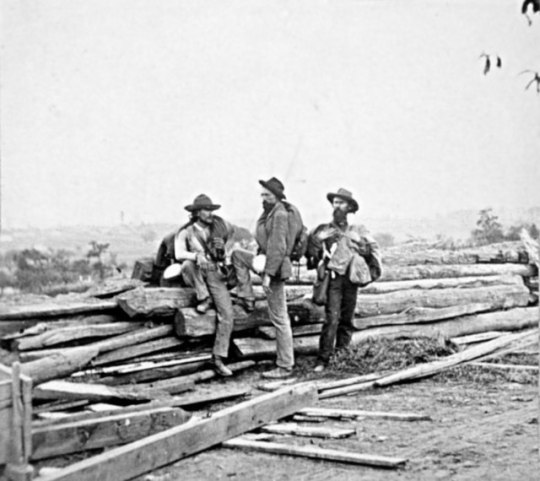
Confederate Soldiers Captured at Gettysburg
[Image Description: A black and white photo of three confederate soldiers resting against multiple, misshapen logs. They are all wearing slouch hats and great, mismatched uniforms along with rolled up blankets. behind them is the clear sky and the hills of Gettysburg]
The grievance theory argues that civil wars are caused by combatant’s sense of grievance against the state or the “other”. Opponents of the greed theory, such a David Keen, argue that greed and grievance are more intertwined than Collier and Hoeffler argue and that they can feed into one another. So really, we should think of it as the greed-grievance theory, where grievance can create opportunities for conflict which creates opportunities to enrich oneself which creates other grievances and so on. In his paper Incentives and disincentives for violence, Keen uses the conflict in Serbia to illustrate how the two feed into each other. Milosevic in Serbia used the media to create grievance amongst the Serbian population and create a common enemy. The elites around Milosevic encourage conditions that warranted international sanctions so they could create a black market where they controlled trade and could loot resources. Milosevic realized that if he ended the conflict, the sanctions would be taken away, and his black-market income would disintegrate. Thus, the stirring of grievances created an opportunity for elite enrichment that proved too precious to end.
The opportunity theory, championed by James Fearon and David Laitin, argues that civil wars likely if there are factors that make it easy for rebels to recruit soldiers and sustain insurgencies. They include poverty, political instability, rough terrain, and large populations as some factors that can increase the likelihood of civil war. Basically, if a state favors an insurgency there’s going to be a civil war.
I tend to agree with Keen that the greed model is too simplistic and even the greed-grievance model is narrow. Like Keen, I think they have to be incorporated into a theory that takes into account several other aspects of conflict generation such as some of the factors Fearon and Laitin identified as well as the perception of state control. All three theories seem to rely on this concept that if the combatants can benefit (whether that be economically, militarily, or politically) then they will risk civil war, but how can a non-state actor benefit if the state itself isn’t perceived as weak in some way? So, there must be a sense of state weakness combined with a sense of something not being gained or given on the part the belligerent actors, a something that was promised (whether as a normal function of the state or through an accepted social/state bias) that can only be gained through armed conflict.
Characteristics of a civil war
Now that we’ve gotten the theory out of the way, I want to spend the rest of the episode talking about common characteristics of civil wars.
Who are the combatants?
When talking about a civil war, the first tell-tale sign that it’s a civil war, are the combatants. Sometimes it can be easy to discern the combatants from each other like in the Irish Civil War, where it was the Free Irish State vs the anti-treaty IRA or the American Civil War where it was the Union versus the Confederates.
Sometimes it gets really complicated like during the Russian Civil War because, not only is it really a bunch of smaller civil wars rolled up into one, but because there isn’t a single point of state authority. You have the Red state versus the White state versus various separatist movements and insurgencies. That’s why I like Jonathan Smele’s book the “Russian” Civil Wars because in reality the only reason we call the civil war a Russian civil war is because all the peoples involved were once part of the Tsarist Empire.

Red Army in Moscow, 1918
[Image Description: A black and white photo of a crowd gathered together in a city square. Two members of the crowd are holding up a banner with Russian writing. They are standing on a brick road. Behind them are several stone buildings.]
If we look at Central Asia, we have Red and White forces battling each other, but we also have fragile semi-states who are also fighting each other whether it be the Tashkent Soviet, the Kokand Autonomy, or the Alash Autonomy or the two remaining emirates: Khiva and Bukhara, plus the Basmachi, a guerrilla movement that wanted to preserve what they deemed to be a proper Islamic society. Then to make matters even more confusing, once the Reds defeated the Whites, they rely on the local state actors to restore order, and with their help overthrow the emirs, but eventually turned on those same state actors, wiping out all they deemed as dangerous and replaced them with state actors of their own choosing. This cannibalization isn’t unusual to see in civil wars and more times than not it occurs amongst the non-state actors. For example, during the Tajik Civil War of 1994, after the Kulob militia were elected to power they turned on an array of rebel groups including the Islamic Renaissance Party of Tajikistan and the Pamirs from Gorno-Badakhshan, which then turned into a nasty bit of ethnic cleansing-which is also common in civil wars.
Identifying combatants can also be complicated because of external interference. We’ll get into this a little later in the episode, but a perfect example of this is the current Syrian Civil War: where Asad’s government is fighting against the various Syrian rebel groups, but the Syrian rebel groups also have to content with Hezbollah, Iranian forces, Russian Forces, and the Islamic State.
Type of Warfare
The type of warfare most commonly seen with civil wars is guerilla warfare or insurgent warfare. Basically, small groups of combatants use tactics such as ambushes, sabotages, raids, hit and run tactics, and petty warfare to attack conventional, less mobile forces. So, Nathaniel Bedford Forrest’s raids during the American Civil War or the Basmachi attacks during the Central Asian Civil Wars.
Often times the insurgents avoid standing battles because they will never win those battles. Instead, they use the terrain to launch hit and run attacks, ambushes, and raids, relying on their small, but highly mobile units to wear the conventional army down.
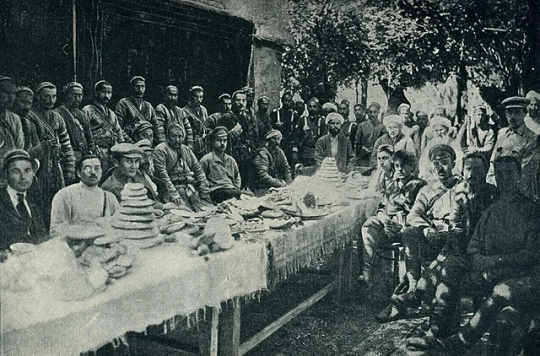
Negotiations between Soviet soldiers and the Basmachi
[Image Description: A black and white photo of a crowd of men sitting and standing around two long tables placed together. Some of the men wear turbans and skullcaps and long robes and long dress shirts while others are wearing the grey shirts and caps of the Bolsheviks. Two clothes are spread across the two tables with several plates of food. The men are sitting in a courtyard with a tree providing shade.]
They’ll also target governmental and military officials as well infrastructure such as supply lines, important governmental or symbolic buildings, and centers of commerce-meaning civilians are also targets. The Provisional IRA turned this into an art as they planted car bombs in large shopping areas. We’ll get into the tricky relationship between insurgents and the population a little later in the blog post, but it should be clear that both the state and the non-state combatants will target civilians when it suits their purposes.
Governments respond by using standard counter-insurgency tactics such as population control i.e., draining the swamp. Expanding zones of control, also known as oil spots, cordon and search operations, winning the hearts and minds of the people, scorch earth tactics, and intelligence operation which includes intelligence gathering, counterintelligence efforts, and assassinations. The Government can also call-in conventional units and tactics such as heavy bombardments, air power, and special forces. Basically, the government doesn’t care how it wins as long as it wins, so it will simultaneously implement conventional tactics and counter-insurgency tactics-sometimes to its own detriment. A good example of this might be the Soviet-Afghan War or the Vietnam War, although those are perfect examples of how extreme external meddling can drastically change the course and duration of your civil war.
I also want to acknowledge that in modern civil wars like in the current Syrian or Yemen Civil wars, governments are growing less and less concern about civilian casualties. While civilian loss is a staple of civil wars, in Syria we’ve seen Assad deploy chemical weapons, which are banned by international law and he has purposely targeted medics and medical infrastructures. Or the purposeful starvation of Yemeni people in their civil war. The accepted “standards” of law are being increasingly abandoned and states are using civil wars to do whatever the hell they want to civilians and rebels with the goal of terrorizing their own people as much as defeating the rebels. This has sort of always been an aspect of civil war, but I would argue that the concept that you need to defeat your own people-even the civilians who are not active-is a new 21st century twist.
Atrocities and violence
Which of course leads us to atrocities. Civil Wars are known for their atrocities and there are hundreds of papers and books studying why civil wars are so violent and bitter and is the violence random or does it follow a pattern, etc. Atrocities always occur in war, but during a conventional war, you’re hurting people who have nothing to do with you. It’s an other, an alien, someone from another country and culture, etc. But with a civil war, no matter how “othered” the enemy becomes, it’s still a neighbor or a family member and so there is this question: why do people get so violent during civil wars? And the disquieting answer is that: the monopoly of power is broken during a civil war. So, in a stable government whether you’re a democracy or a dictatorship, there’s an understanding between government and people: do these things or be these things and the chances of state violence against you will be low.
Now I’ll acknowledge that there is randomized terror, such as the Soviets perfected or any modern-day dictator, but even dictators, or the ones who want to survive, know that there is a balance between being a crazy maniac that people will risk everything to overthrow and the right amount of violence to maintain absolute control. As long as this agreement holds, the state has monopoly over violence. But something happens where this monopoly ends-or it’s perceived to end-and other non-state actors now have the ability to employ violence to maintain control of their areas. And so, violence becomes the new political, economic, or social currency. Kalyvas, in his book the Logic of Violence in Civil War argues that civil war violence isn’t random, it only occurs in disputed territories (where the monopoly of violence is most tenuous) and is driven, not by the conflict itself, but by old rivals and wounds in the population.
Which brings us to another reason why civil wars can be so violent: civil wars exasperate existing tensions. Whether it be class based, race based, or religion based, if there is a problem plaguing your society, a civil war will make it worse. We see this in Central Asia. Take the Tsarist government away and the tensions between the settlers and the indigenous peoples explodes into a conflict, the internal conflicts within the indigenous peoples explodes into various conflicts, the white and red-the supporters of the status economic and political quo and those who want something different-take their conflict into the region. We can see this in Syria with Alawites pitted against the Sunni peoples, the Ismaili as well as against the Kurds and the Druze, and so on. During the Irish Civil War, it wasn’t just an IRA man against an IRA man, one of the main grievances was the influence of the British in the Cosgrave government as well as the reincorporation of the Unionists or loyalist, who didn’t support the IRA during the Irish War of Independence.
So, civil wars are violent, but who is on the receiving end of that violence? It’s mostly civilians which makes sense since the non-state combatant’s best way to survive is to avoid open warfare and the state government has a hard time finding the non-state aggressors. So, who’s caught in the middle? The civilians.
Non-state combatants employ violence to either punish perceived collaborators or enemy agents, to increase the price of continuing the war (i.e., terrify and anger civilians so much by indiscriminate violence that they demand their government end the conflict now), to get revenge/attack “hated” peoples, and/or to extort the population of their support, their people, and/or their resources. Jeremy M. Weinstein, in his book Inside Rebellion: The Politics of Insurgent Violence argues that insurgents that control lands rich in natural resources or are financed by external forces are more likely to commit high levels of indiscriminate violence than those in resource poor regions. Which makes sense. If you need to rely on civilians for support, supplies, and resources, you’re not going to want to anger them whereas if you can just extract your wealth or are being supported by an external force, why care about the people under your care? Then there’s ethnic cleansings/acts of genocide. The Russian Civil War is full of moments were non-state actors would attack their favorite people to hate whether that be the Jewish people of their region, the indigenous people of Central Asia, or just old fashion peasants.
And then there are cases where attacks led to unintended casualties or more civilian casualties than expected. This happened a lot with the Provisional IRA’s bombing campaigns.
The government targets civilians for similar reasons. They want to punish anyone who supports or aids the rebels, they want to increase the price the rebels have to pay to engage in a specific region (ala Sherman when he burned the south), and/or they need to reassert control. Civilian targeting can also be a component of intelligence efforts as they try to take away all support from the rebel groups. Similarly, the state can also engage in ethnic cleansing/acts of genocide. Again, during the Russian Civil War, both the Red and White armies engaged in launching pogroms against their Jewish populations or the bloody work of the Yurchiki during the Tajik Civil War. The Yurchiki was a Russian based unit sent to Tajikistan to assist the government and are responsible for so many atrocities it is rumored even European human rights organizations played them down. And just like an insurgency, the state can also have unintended casualties or more civilian casualties than expected. As I mentioned earlier, in civil wars like Syria, the civilian is purposely and indiscriminating targeted and it’s hard to understand what Assad thinks he’s achieving by targeting hospitals and medics and civilians in pro-Assad regions.

Destroyed remains of Guernica during the Spanish Civil War
[Image Description: A black and white photo of several demolition buildings. Piles of building rubble fill the streets and smoke is thick in the air.]
However, civilians aren’t the only ones who experience atrocities. Soldiers and governmental officials are also common targets which means that they too can be victims of extreme violence. During the Irish Civil War, the anti-treaty IRA assassinates Free State officials such as TD Sean Hales as well as Pro-Treaty family members such as William Cosgrave’s uncle and Kevin O’Higgins’s father. The Fort Pillow massacre during the American Civil War is a prime example of killing prisoners after they’ve surrender, a horrific act of extreme racism, and an attempt to intimidate supporters of the Union. In short, Forrest led an attack on Fort Pillow and won. He massacred 300 African-American soldiers refusing to treat the soldiers as traditional prisoners of war.
Governmental forces are no different. During the Irish Civil War, the Cosgrave administration legally executed 77 prisoners of war while members of the Free State army implemented their own executions. The most famous case being the landmine of Ballyseedy. Nine IRA prisoners were tied to a landmine which was detonated and only one prisoner survived. During the Russian Civil War, the Bolsheviks and the Whites implemented their own Terrors, where they carried out extreme forms of political repression and mass killings. Violence isn’t only physical violence, it can also be the taking and redistribution of property, mass expulsions, and forced conscription of people or food. For example, during the Central Asian Civil Wars, the Jadids and Bolsheviks took all property from the Ulama, breaking their source of power and leaving them homeless and without resources.
External Interference
Like all other wars, external actors love getting involved. A civil war opens your country up to external meddling whether it be financial support, international investigations into the conduct of the war, or military support. In the Irish Civil war, the British government gave artillery to the Free State so they could defeat the anti-treaty IRA troops barricaded in the Four Courts, during the American Civil war, England and France considered supporting the Confederates, during the many civil wars that make up the Russian Civil War, Britain and the United States got involved in all sorts of way, and in the Libyan, Syrian, Yemeni, and every other current civil war, Russia, the United States, and usually Iran are involved.
What does this mean for a civil war? Well, that depends. Sometimes external interference can mean that one or more of the actors are recognized as legitimate. It can pressure the state to find peace or it can empower the state to keep fighting. Often times external actors can muddle a civil war, they can extend a civil war, and they can turn civil wars into proxy wars, like the Soviets in Afghanistan, the United States in Vietnam or Korea, or the Russians ever growing presence in Syria. Syria is not quite that bad yet, but Russia is heavily involved and can serve as a stand in for state power in many different ways. External actors can also feed into rebel’s worst natures. For example, if they make a rebel group financial independent, then we may see rebel groups engage in indiscriminate violence.
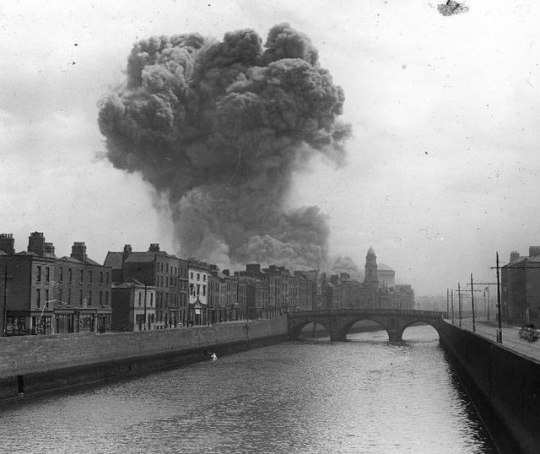
The Provisional Government bombing the Four Courts, using ammunition supplied by the British
[Image Description: A black and white picture of a river and the streets on either side of the river. The river is calm. The streets are mostly empty and there are several buildings on each side. A stone bridge ran across the river, connecting the two streets. A large grey and white cloud billows in the distance, taking up most of the sky.]
And finally, civil wars are great ways for most powerful states to experiment with new systems and tools of warfare without technically being in a war themselves. The most famous example of this, of course, is the Spanish Civil War which the Nazis and Soviets turned into their own experiment lab for tactics and weapons they’d used during WWII. And I think we’re seeing some of this in Syria, Yemen, and even the current Ukraine conflict which is a weird hybrid civil war of sorts.
Long-lasting Effects
One of the most damaging characteristics of a civil war is the long-last effects. Because a civil war is so violent, because the people themselves are the target, and because it can invite outside intervention, civil wars rarely end when the fighting stops. Civil Wars change entire physical and political landscapes. Civil Wars can ruin farmland which may lead to mass starvation that can last for years if not decades, can eliminate industrial capabilities, and can redistribute control over resources and economies.
Civil Wars can overthrow the ruling powers but can also enrich them and strengthen their hold. They can fundamentally change how people understand their political systems or they can enforce existing structures including inequalities. Civil Wars exasperate social and economic tensions within a sovereign entity and I don’t think a Civil War has ever made them better. They’ve only made them worse, which can contribute to future conflicts or ethnic cleansings.
Civil Wars can change international politics, making certain states more reliant on others, weakening external actors in surprising ways, and pulling entire regions into a death spiral of civil wars and interstate wars.
Civil Wars can wipe out entire peoples and their culture, fundamentally reshaping a nation’s demographic and identity. They also create massive refugee and humanitarian aid crises. And even if the surviving authority maintains to weather all of these long-lasting effects the trauma their society has endured does not end. It gets passed down each generation and can become a festering wound that may not kill the state, but can weaken it.
In his book, the Logic of Violence in Civil War Kalyvas writes this fascinating passage:
“This book introduces a different mechanism for mapping national-level cleavages onto the local level, one that is consistent with the observed disjunction between center and periphery: the mechanism of alliance entails an exchange between local and supralocal actors, whereby the latter offer the former military muscle so that they can prevail in local conflicts; in return, local actors supply central ones with essential local resources that help them wage the war. Myriads of local conflicts are thus linked to the overarching conflict of the civil war – its “master cleavage.” Seen from this perspective civil war is, at its core, a process of integration and state building.” - Stathis N. Kalyvas, The Logic of Violence in Civil War, pg. 14
Basically he’s talking about the relationship between the actors at the center and local actors and, how even though local actors engage in violence at contested locations and usually engage only to settle old scores and for local political reason, the act of violence is dependent on the central and local actors working together and thus shapes the direction of the war, often times reshaping boundaries, even if they’re just local boundaries, and thus it becomes an act of statecraft and integration.
It’s probably no surprise but the idea of civil war as a tool of state building fascinates me. I love to study asymmetrical conflicts at the point where non-state belligerent actors must transition from warfare to statecraft and we’ll actually be discussing that process in this current season because that’s exactly what the Bolsheviks and Jadids have to do during the civil war. And it’s something we’ll return to when we cover the Irish Civil War. But this concept of civil war equals state building is fascinating because I think we often think of civil wars as inherently destructive and terrible things, which they are. Just go back to our discuss about the atrocities committed during civil wars if you need to confirm that they are indeed terrible. But it’s also interesting to think of the ways that new institutions and centers of power are crafted by civil wars and if we focus on the few productive things that can come out of civil wars, then can we find a way to resolve them, not only quicker, but in a more peaceful and long-lasting way. Or can we at least craft tools that either the state itself or the international community can put in place to prevent civil wars from becoming destructive, violent, suicidal conflicts?
This idea reminds me of one of my favorite passages from Tadeusz Konwicki’s book a Minor Apocalypse, “the world can’t die. Many generations have thought the world was dying. But it was only their world which was dying.”
Resources
Iraq’s Civil War by James Fearon
The Logic of Violence in Civil War by Stathis N. Kalyvas
Neverending Wars: The International Community, Weak States, and the Perpetuation of Civil War by Ann Hironaka
Greed and Grievance in Civil War by Paul Collier and Anke Hoeffler
Incentives and disincentives for violence by Dan Keen
Ethnicity, Insurgency, and Civil War by James Fearon and David Laitin
Inside Rebellion: the Politics of Insurgent Violence by Jeremy M. Weinstein
A Minor Apocalypse by Tadeusz Konwicki
Strategy by B. H. Liddell Hart
Learning to Eat Soup with a Knife by John A. Nagl
The Russian Civil Wars 1916-1926 by Jonathan Smele
Destroying a Nation by Nikolaos van Dam
Syria After the Uprising by Joseph Daher
The Soviet-Afghan War: How a Superpower Fought and Lost by the Russian General Staff
The Hidden War by Artyom Borovik
Russia in Flame: War, Revolution, Civil War, 1914-1921 by Laura Engelstein
Imperial Apocalypse: the Great War and the Destruction of the Russian Empire by Joshua A Sanborn
A Nation and not a Rabble: the Irish Revolution 1913-1923 by Diarmaid Ferriter
Judging W. T. Cosgrave: the Foundation of the Irish State by Michael Laffan
Say Nothing: a True Story of Murder and Memory in Northern Ireland by Patrick Radden Keefe
Making Uzbekistan: Nation, Empire, and Revolution in Early USSR by Adeeb Khalid
Green Against Green by Michael Hopkinson
#history blog#civil wars#irish civil war#american civil war#spanish civil war#central asian civil wars#russian civil war#asymmetrical warfare#queer historian#activating political science powers#Spotify
0 notes
Text
bro I’m fking dying homosexuality was decriminalized in CHINA before the US (nation-wide). y’all’s racism in seeing China as a “backwards” country has really gotten to me smh.
#gay#gay rights#idk how much i want to tag this as#I said this#chinese school dropout life#usa#china#queer history#gay history#china was 1997. us 2003.#for context the uk was 1967 and one of the nordic countries was the earliest in like the 30s or 40s#the offical chinese government laws against homosexuality are essentially the same as the Section 28 (UK 1988 (?) to 2003)#yeah 1988#and also the american laws such as florida's recent 'Don't Say Gay' one#actually that's not all the details#gay marraige isn't legal but that's kinda part of their population control stuff#besides i believe taiwan was the ONLY Asian country with legal gay marriage until very recently.
0 notes
Text
I think this whole Palestine thing was a huge wake up call for so many people around the world. we no longer glorify fake celebrities who turned a blind eye to genocide, we're no longer consuming whatever the media provides, we're no longer obsessed with fascist bloodthirsty brands, we no longer believe the mainstream media, and we're no longer intimidated by police or threats of losing our jobs or degrees. we're no longer believing in the false narratives we've been fed about Palestinians and Arab people, we're no longer separable. I've seen Jewish people leading protests for Palestine, I've seen black people, Asians, native Americans, Arabs, and white Christians, Buddhists, Sikhs and atheists marching together as one, I've seen Muslims defending queers during the protests, I've seen nothing but love and support... yet some people out there trying to convince you that students protesting is some sort of terrorism sympathy and violent riots. I've seen people picking up history books and educating themselves, I've seen the youth reading about Palestine, I've seen people from all parts of the world, from different religions, ethnicities, and sexual orientation and gender identities, all sitting together in camps sharing food and songs, I've seen things that white supremacists spent too long trying to prevent and I'm very proud of every single one you. Let's keep it up
#free palestine#palestine#gaza#free gaza#end the genocide#fuck zionazis#fuck israel#fuck the media#jews for ceasefire#jews for palestine#blacks for palestine#asians for palestine#christians for palestine#lgbtq#queers for palestine#free rafah
96 notes
·
View notes
Text
Representing Biracial Black South American Experiences…Through a White/Asian Mixed Race Character in Europe
@colombinna asked:
I have a YA story that's in very early development - pre-alpha, if you will. For now what I have developed is the characters: one of the MCs is a biracial asian queer girl (her dad is thai-american and japanese, her mom's white), she has a medium/dark brown skin, and lives in a very white context in a fictional European country. The contact she has with her extended family is limited to phone calls and regular visits because her dad moved from the US to said fictional European country.
I'm a biracial black queer girl myself, living in a very white community in South America, my extended black family also lives in a different place, and I'm taking a lot of my experiences of being not white and queer whilst living in white communities into her story (the feeling of not belonging, the impostor syndrome, standing out as one of the only POC kids in class, etc) and thinking back to what I've heard asian friends and classmates say about their experiences in the same school/community context as mine. But I want to know how different her experiences as a dark-skinned asian girl would differ from mine and my friends' in a similar context (white community, small number of other asian people - and POC in general - in the social circles, and limited contact to her extended family), and what experiences could make sense if the character was biracial black like myself, but won't if she's biracial asian.
Why not write a biracial Black girl if those are the experiences you want to represent?
This MC is straddling, like, 3 different cultures. Having multiple immigrant identities in not-Europe is not the same experience as being Black in South America; while both are complex minority experiences, there are too many differences in intersections and histories to compare. Not to mention, it really depends on what European culture(s) you’re basing your not-Europe on.
I think you’ll find that the written result will ring much more genuine and rich in depth if you either translate your experiences more directly or pick a more narrow focus, instead of assuming that there is a universal for racism and colorism against biracial people that is transferable across contexts. Because there isn’t. There can be overlaps, but if you’re looking to cover the entire range of What It’s Like in general, it won’t work.
This isn’t to say that people can’t use other identities to write about specific experiences of their own, but in this case you need to think about what story you want to tell and what your reasons are. Marika’s commentary will go more into when and how this can be done effectively.
Also, if the point is to make her a dark-skinned Asian, as a white/asian mix myself, I implore you: why must you make her 1/4 Japanese and 1/2 white? Even with the Thai ethnicity thrown in, Thai people very much range in skin tone and have their own domestic issues with colorism. It’s not impossible for dark-skinned examples of your MC’s ethnic makeup to exist, but still I don’t recommend it for two reasons:
It's going to make researching people whose experiences fit that much more difficult. Most experiences of colorism, othering, and other forms of discrimination that mixed white asians tend to face are completely different from mixed race asians who tend to have darker skin & features.
There's enough Japanese & white mixed Japanese rep in the Asian rep sphere as is. Consider that this individual could be mixed Asian (not Japanese) with something else (not white)!
But again, think over your motivations. I’ll spare you the copy/paste of our Motivations PSA, but re-read it and consider. Why do you wish to write a mixed Asian character to tell the story of your experiences as a mixed Black individual instead of a mixed Black character? What does it add to the story? Is it an effective vessel for the experiences you want to convey?
~ Rina
I think Rina brings up some good points here: I’m not hearing a lot of specificity in your query. As you doubtless know firsthand, the more intersectional and complex an identity, the more of a chance the identity may come with unexpected baggage and nuances that fly in the face of what is common sense for less intersectional identities. This can make writing such characters challenging just because there is so much choice on which identity themes to emphasize.
I once spent about 15 minutes explaining to a person the thought process I used to determine when I could wear jeans depending on which country I was living in as a mixed race person who is perceived as different things in different places. It might seem trivial, but it’s actually very important to me for the purposes of identity, safety and gender presentation, so I personally think it’s interesting. But will my readers think a character’s multi-page internal monologue on whether or not to wear jeans is especially compelling? Does the writer-version of me want to research the version of myself musing on my specific jeans conundrum to that extent? Or do I want to talk about other things related to attire a lot of other people would relate to? I think those are all YMMV questions, but hopefully, they provide some perspective that will help you be intentional about how you might want to tackle something potentially very time-consuming.
When I say intentional, I mean that when covering a complex identity with which you are peripherally familiar, it will always be more effective and easier to use it to tell a specific story extremely clearly than to be extremely broad in scope and try to include almost everything about your own experiences, especially because some of those experiences might not be as relevant for your character’s background as they are to yours.
One of my favorite childhood picture books is written and illustrated by a Nikkei writer-illustrator team. The book is titled Ashok by Any Other Name (link). The story features a desi child growing up in the US who wishes he had an American name his friends and teachers wouldn’t think was strange. It covers how being othered for his name makes him feel, and how he copes with that feeling. Speaking as someone both Japanese and desi, I think through the plot device of names perceived by the majority of Americans as foreign, this book aptly shows how many immigrant/diaspora creators are capable of relating to the pressures of assimilation experienced by other immigrant, even if the creator, the audience and the story’s subject’s backgrounds all don’t completely overlap 100%.
There will be aspects of your Blackness, mixed identity, skin color, sexuality and living in a local community lacking diversity as a member of many minority groups that you will find resemble/ resonate with the experiences of mixed-race, Japanese individual in a Europe-themed setting, and I think any story that leans into those themes will be considerably easier for you to research. In other words, instead of asking us “How does my experience differ?” I would approach this issue by deciding what narrative you want to show about your own experience and then research the specific contexts within which your desired story overlaps with elements of mixed-race Japanese experiences.
- Marika.
#japanese#mixed race#biracial#black#black woman#asian women#multicultural#multiracial#pov#identity#representation#asks
392 notes
·
View notes
Text
no one does it like the polynesians



source
#aapi month#asian american pacific islander heritage month#queer asian american history#polynesian#hawaiian#yall deserve so much respect and recognition. in general not related to this#queer#lgbt
43 notes
·
View notes
Note
Have you read any of the Thai academic papers regarding MAME's work? sometimes I feel like fandom at large has a very strong western bias towards her that borders on xenophobia in review of anything attached to her unless it's more low stakes gmmtv style stuff like wedding plan was which suits western sensibilities more.
Hi, Non! This is interesting framing you've put forth here. I want to note that I'm close with some folks, particularly @bengiyo and @lurkingshan, whose critical tastes I trust, and I can assure myself that they would not call Wedding Plan low stakes. During my Old GMMTV Challenge project, I promised myself that I would not watch another MAME show after Love By Chance and TharnType, and I've taken Ben's and Shan's urging to chuck that aside to add Wedding Plan to my OGMMTVC syllabus, which I'll get to after my summer travels. Let me take a second to sort this all out in a more sensible and chronological answer to touch upon what I know about MAME now that I'm much more read into Thai BLs and the history of the genre.
Regarding academia and MAME, I have not read Thai source material on her start and her legacy in Thai Y novel writing and Thai BL/Series Y television productions. What I am in the midst of reading at the moment is Dr. Thomas Baudinette's Boys Love Media in Thailand (Baudinette hailing from Australia), and he does get in depth with MAME's beginnings, which for me was the first primary source material that I have encountered about her background. To summarize quickly, MAME (along with individuals like INDRYTIMES/Kwang Latika, who wrote the original novel for Love Sick, and others) was part of the first crop of young middle-to-upper-class female college students who became enamored with Japanese BL/yaoi manga, as well as (in many cases) K-pop idols, and began writing fan fiction about and/or in the styles of these interests, which led to the development of the unique Thai Y novel genre.
It does seem to me, at least on Tumblr, that a good chunk of Western fandom here has written off MAME. I'm Asian-American, and I come to my hesitation about MAME from a particularly Asian perspective, so I really can't speak for the non-Asian fans about what they're rejecting. Let me at least explain what I'm rejecting, and how I've engaged in dialogue about it with critical friends here.
LBC did not have as much of what I will attempt to describe as I saw in TharnType, something that I might now call collectivist homophobia or collectivist bias. But LBC had a smattering of it, something that I smelled early on in that series. In both series, MAME seemed to approach her characters, to me, with a distanced hand of judgement that, to me, recalled the kinds of biases that my Asian parents tried to implant in me in my childhood, that I rejected throughout my young years. Queer material is so very often not good to its queer characters, and it seemed to me through LBC and TT that MAME intended to gild that lily to channel a populist homophobia that she seemed to know would resonate with a broader fanbase -- which it did, in part, because TharnType in particular was the first Thai BL with heat in every episode.
(Two things to note about my review of TharnType that I penned last year. First item to note is that Boys Love Media in Thailand had not been published yet, and I had not read primary source material about MAME. I was enraged at the time about fan theories that MAME had been a victim of sexual assault, and had therefore written her queer characters with the biased vitriol that I perceived coming from her because of that theorized past. I still think these theories are equivocating and problematic. Second item is that I heavily recommend reading the reblogs of my TT review, tags and posts and all, to see literally the spectrum of commentary of the MAME fandom/anti-fandom across Tumblr. Writing that post and reading those reblogs was a hell of a great experience.)
Just to summarize this, then -- I choose to not engage with MAME because I see under- and overhanded bias in the work that I've watched, with my Asian eyes; and I just might assume that many Westerners see the same thing. But I don't really know, because I haven't talked to that many Western fans about the depth of this.
So what does this mean for this moment in time? I understand MAME's Love Sea is airing, which I'm not watching, and I missed the boat on Love In the Air -- so I think I'm missing some critical and/or catty chatter about those two shows from the fandom because I don't have context.
But I do know there are folks out there that either write MAME off wholly, likely for similar reasons that I've listed above, and/or hate-watch her shows and post about it. To each their own.
I would not have considered Wedding Plan if Ben and Shan weren't screaming about it. I'm happy to have fewer shows on my plate, I got no time. However.
Nothing in this world exists in a static vacuum. If MAME is experimenting with tone, approach, style, and even taste regarding her shows, then more power to her. @bengiyo's post linked above about Wedding Plan is important for me to see, because I see that he's noting that parts of the fandom may have actually demonstrated real homophobic dialogue about MAME's fictional characters, which, to me, I'm like, what? Really? You got time for that? But also:
If MAME, back in 2019 with TharnType, picked up that her Thai and global fanbases were more inclined to check in with collectivist homophobia, as I'm calling it.... and now, in 2023-2024, has noted that her fanbases might be far more inclined to support real queer equality and overtones in shows, and is including those themes in her work -- can we not welcome that change in? That's why I'll give Wedding Plan a shot.
Let's be sassy and ironic for a second. Could she be making this change for da money and the fame? Sure. But -- capitalism unfortunately rules this world. Car commercials in the States have interracial queer couples parenting children nowadays. If equality talks to money, then content makers will take note. I think I'd be a hypocrite to say that MAME shouldn't make her dollar, all while she's experimenting with more equitable stances.
Last note. There's been quite the dialogue simmering these past few weeks about GMMTV's We Are, and whether or not GMMTV is stepping away from a past where many (not all, but many) of its shows explored queerness in depth. He's Coming To Me, Bad Buddy, Dark Blue Kiss (yes... the first three shows I listed were Aof Noppharnach shows, fuck), Theory of Love, 3 Will Be Free. The major GMMTV BL/GL shows that have aired recently that have made huge waves on social media -- Only Friends, 23.5, Last Twilight, and now My Love Mix-Up -- were/are helmed by branded (capitalism, hello!) pairs, and three out of four of them were flops, with MLMU already treading that territory in EPISODE TWO, for heaven's sake. (Y'all, read the reblogs on this post. Wow.) I finished a rewatch of The Eclipse weeks ago, and I'm dragging my feet on my review, because of what I think that show represents for what branded pairs end up doing to otherwise original content.
I want to posit a theory, that I'll work more on when my OGMMTVC is over, that we have living, real-time proof that the branded pair system is failing good content -- because these shows have to produce engagement snippets of these pairs, instead of more broadly penetrating artistic content. GMMTV's one-off shows with non-branded pairs, like Be My Favorite and Wandee Goodday, are FAR MORE INTERESTING content-wise, varied and inquisitive in their artistic takes on queerness. Even Cherry Magic, featuring the long-awaited return of TayNew, felt fresh, because we literally hadn't seen TayNew in FIVE YEARS. Tay actually KISSED ANOTHER DUDE, shocker!, in 3 Will Be Free. I want to go back to those days, where the pairs could act well outside of their range and their business partners, instead of being limited to the same tone and style that their pairings and their fandoms demand.
I say ALL OF THIS, because isn't it interesting that GMMTV seems to be reverting on a scale of inquisitiveness about queerness -- and MAME seems to be going in the opposite direction?
I would not have expected it. But I have found, lately, some of GMMTV's "takes" on "queerness," as in Only Friends, to be outright offensive. This corporation has become far more gunshy to let their branded pairs just be fictionally gay. If MAME wants to take on a healthier stance of equity, and to play around with more realistic depictions of what it means to be queer in Thailand, then go for it, girl. I will admittedly be watching Wedding Plan with my Asian side-eye and my smell tests for bias, but I look forward to being proven wrong about my suspicions. I want to be a responsible fan here, open to MAME's changes.
This ended up being a lot, but thank you for provoking these thoughts, Non.
#thanks for the ask!#mame#wedding plan#wedding plan the series#tharntype#love by chance#let's be real here as well for a second#people are likely shitting on MAME on tumblr for clout#which#...#those folks should touch grass and move on!
74 notes
·
View notes
Note
I don't understand, what's going on with Taylor and Matt trash being a couple? Could you explain to me?
nothing is really going on at the moment tbh, cuz they broke up a pretty long while ago, but the issue is the album (if that's what you're referring to) and taylor swift herself.
[will add sources and more stuff when I find the links and if I realise I missed something out, cuz this is a general thing based off of memory]
Context: dating history
Basically she and matty had been friends for a few years (there are rumors of them hooking up ig in 1989 era maybe, but I don't really care enough to believe shit like that). Apparently he had also been pining for her (according to stuff he said in interviews and tweets) for years, but again, you can still chalk it up to rumors if you wanna.
The thing is that post her breakup with joe alwyn, she started dating him (in like april I think) [there had been dating rumors of them since 2014 tho, and again in March 2023] and the fandom kinda got divided.
Here is the link to their entire timeline
Context: what matty healy did
Matty healy (you prolly know this) is basically racist, sexist, antisemitic, homophobic and God knows what else I have missed out or not been aware of. He did shit like doing the nazi gesture on stage, mocking asian accents, tastelessly making fun of ice spice on her race and bodyshaming her, laughing and basically confirming that he watches violent rape porn of black women on a site that is known to be highly problematic and force their actors (gender neutral) to do things they dont consent to (there was also an actress who was assaulted or something but im not informed on it). Even when he was called out on stuff like this, he accused people (who were poc, btw) of overreacting.
Context: taylor and activism
Taylor had also, in the past (lover era, and miss Americana the doc) had talked about how she had been too quiet about political issues and politics itself for too long, that she understands her influence and power in society, and that she "needs to be on the right side of history" and even specifics such as that she thinks it's spineless to go on stage and say "happy pride month" and not acknowledge the political oppression that queers in USA were facing (something about a bill or the republican party idk man I'm not american, i dont remember but i did research when i watched the doc tho). She has claimed she was gonna be clear about where she stands (many republicans had considered her to be one, and many thought she's conservative or something, but she was always quiet about it, until the lover era). However, she just stopped that activism after the lover era, and went back to being quiet on where she stands (I've seen many swifties refer to the lover era as the activism era) and hasn't spoken about anything substantial really. She did some things like post a black square with 13 hearts during blm, and stuff that every celeb who wasn't openly a pos did, but that's kinda it. Even as a self proclaimed feminist, she didn't speak up on issues such as roe v wade, or about an issue regarding drag queens despite having them in yntcd, or talking about trans/queer rights until she was in a blue state (im not an American, I just like to keep up a little with stuff in usa cuz it's always up in my face sadly, and thus i cant be specific, but anyways, correct me if I'm wrong, or if I missed something).
So even after saying she'll be vocal, she was just... not. And that's basically her on politics or giving a shit about minority communities.
Context: Fandom's reaction
Swifties were extremely disappointed that taylor CHOSE to associate with a man like this, and there were fans calling her out, and she received backlash, too.
Most of these swifties were poc (myself included) and they felt hurt that an artist that they not just supported and developed such a deep connection with, but also financially supported for years, would have such disregard for them. Not just was she dating him, but she kept saying things such as "I have never been happier in all aspects of my life" or saying "I love you" or "uk who you are" in romantic songs on the tour, which was just adding insult to injury. She also did a collab with ice spice (which was completely out of nowhere, and the collab itself seemed badly made and rushed), which fans and others speculated to be a pr cover up for the fact that matty healy had mocked her (many ppl also believed that it was too quick for it to be a pr cover tho).
Now, in the fandom, when poc swifties were calling her out on dating mh, (mostly) white swifties started harassing poc swifties for doing so, or saying that they are hindering with her happiness or some bs about it being "just a fling" (again, myself included). They said it's the same as seeing a friend get out of a long-term relationship and make bad dating choices, and poc swifties should let it go (as if taylor is our close personal friend). In a mostly white fandom, poc swifties felt alienated and sidelined.
Ofc, taylor never addressed any of this backlash, and after she broke up with him, there were articles saying that sources say (which mostly means her pr team atp) that her breakup had nothing to do with his controversies or behavior.
The album release (lyrics, references and reaction)
Now, with the release of ttpd, contrary to what most of the fandom believed, most of the songs on both the albums are believed to be (and heavily hinted on) about matty healy. These include 4 songs- "ttpd", "but daddy I love him", "I can fix him (no really I can)", and "guilty as sin?"
Ttpd, the title track, talks about mh being "a tattooed golden retriever" (wtf) and about him love-bombing her, and her pining after him, thinking about marriage and shit. But daddy I love him and I can fix him, are basically that no one supported her dating decision and she's claiming that she loves him oh so goddamn much, but more importantly, her talking about her fans' reactions. Specifically, describing her poc fans to be "vipers" and "judgemental creeps" who hate her and them being hurt as "bitching and moaning", and basically took the side of the (white) fans who defended her, indirectly. She described his racist bs as "crazy" and said shit like she could "handle a dangerous man." She also has another song, "Guilty as sin?" and while I genuinely don't give a fuck about what she chooses to do in her private life, unless it is problematic, it is about her fantasizing about being with that racist man while being in a long term relationship with joe alwyn. She sings about how she wants him and wants to be with him... in multiple ways, iykyk. Again, out of context, I love this song so much, but that doesn't erase the context, right?
She also has a song "I hate it here" where she says the following lines:
"My friends used to play a game where
We would pick a decade
We wished we could live in instead of this
I'd say the 1830s but without all the racists and getting married off for the highest bid"
And while there are many reasons why this line by itself is racist (romantisization of a time that was extremely shitty to many communities, most of which she is not a part of, showing herself to be "oh look I'm so woke I still remember the bad things even when I romanticize bad eras in history" which is something you expect from an ignorant white high schooler maybe, not a 34 y/o billionaire who claims to be well-read, etc.) but taylor swift herself saying these is adding insult to injury cuz she has shown time and time again she has no problem with racism (she kept quiet when antonia gentry, a black actress, received hate and racist threats by swifties because of a line BY NETFLIX that taylor didn't like, and she shouldn't ofc, but it wasn't the actress' fault), or associating herself with them (matty healy, for example). It is hypocritical to write something like that after writing an album about pining after a man and his "dangerousness," which is just bigotry. Way to romanticise racism, sexism, and antisemitism, taylor.
Even now, after listening to the album, she clearly doesn't like mh anymore, NOT because of his actions, but because he broke her heart, showing that she still enables and is okay with everything he did.
And that's kind of it (ig) about her and matty healy. I'm not really sure exactly which part you wanted to know, so this is just a gist of it all. Hope it helps :)
#taylor swift#matty healy#anti matty healy#the 1975#joe alwyn#ts ttpd#ttpd era#taylor swift ttpd#ttpd spoilers#ttpd anthology#ttpd analysis#ttpd album#ttpd lyrics#ttpd release#ttpd reaction#ttpd review#ttpd speculation#ttpd tracklist#ttpd the anthology#ttpd taylor swift#ttpd theories#ttpd thoughts#ttpd#the tortured poets department#taylor nation#taylornation#swifties#anti taylor swift#taylor swift critical#asks
77 notes
·
View notes
Note
I hate it when I can't use a term that fits me very well because my brain (which processes everything with images) has an image of that term that doesn't look like me.
Like when I think of "transmasc" and all that pops into my head are skinny, white, American boys with very basic styles (which isn't a bad thing, it's just "too basic" for me personally), and of course, who look like cis boys and hate their bodies or prefer other body.
Meanwhile, I'm a POC, fat, Latine person, with questionable style (/joke), who CERTAINLY doesn't look like a cis boy and who really loves their body.
How could I use a term when my brain tells me that term doesn't fit people like me? I hate that. It's just me?
hey anon. i so wish I could reach through this screen and tell you that who you are is perfect and that you have every right to terminology that feels right, but as a fat trans person myself I know it takes more than kind words to deal with a pain like this, and one that’s even more intersectional than mine with your race and culture in the picture.
but that image you have in your head of what transmasc means, that is not the reality. that is what a small part of the community, of the world, WANTS you to think because they would rather throw other members of their community under the bus to gain faux acceptance for themselves, which is NOT your fault, but it’s also not everyone, there are so many people in this community who look like you or who truly stand with you. Transmasculine history is and never has been white or thin or any of that.
I’m going to link a few things you may want to look into if you’re wanting to start accepting your identity a little more, or just to see that you really ARENT alone. trans men/transmascs of color have been part of our history since the beginning. some of these things im sharing may be somewhat nsfw and have the word 'tranny' in them, just as a warning if that stuff bothers you.
newspaper clipping showing three trans men of color at a festival for a film they were part of, the first ever sexual/porn film by and for trans men of color
some pictures showing some fat trans men and trans men of color at marches are here
Bobby Cheung, the Asian and Pacific Islander trans man who won the Mr. Transgender San Francisco Pageant in 2004
trans men of color discuss intersectionality in a film they directed called "Trappings Of Transhood"
a photo showing the attendees of an FTM conference- you can see many non-white people in attendance
a photo of a group of Latino trans men who attended Tranny Fest in 1999
basic info on victor j mukasa, a Black transmasc lesbian active in East African LGBTQ rights scene
an older fat trans gentleman's photo and experience
a post on pauli murray (please look them up. his experience is much more nuanced than this post gives them credit for, and she was a wonderful intersectional activist)
various trans men (many fat and of color) who have contributed to our history
a conference of Indian trans men
the story of a trans man named Ben
one of my personal favorite transmasc historical figures, Amelio Robles Ávila
Zander Keig, the fat Latino trans man who won social worker of the year in 2020
a wonderful read on the intersectionality of transmasculinity and race
a digital archive of trans and queer Latino history
the Instagram page of a popular Black drag king
an article with interviews with various drag kings, including several of color
Florence Hines, the Black drag king once called the most excellent male impersonator in America
more drag kings many of color!
Drag Kings: An Archaeology of Spectacular Masculinities in Latino America
anon, it is so easy to feel like you are alone when your own history has been unfairly erased from you. but when I say “you are not alone”, I am not offering empty words of comfort- YOU ARE NOT ALONE. Transmasc and similar identity has truly NEVER actually been just for white people or thin people. You are WONDERFUL, and you are ABSOLUTELY a part of trans masculinity and transmasculine history is YOUR history and community as much as it is mine and others. You belong.
318 notes
·
View notes
Text
This Valentines/Aro Day
I'm sharing my Arospec/Black/& Polyam book haul!! ft. Romance or Queer Platonic Relationships!

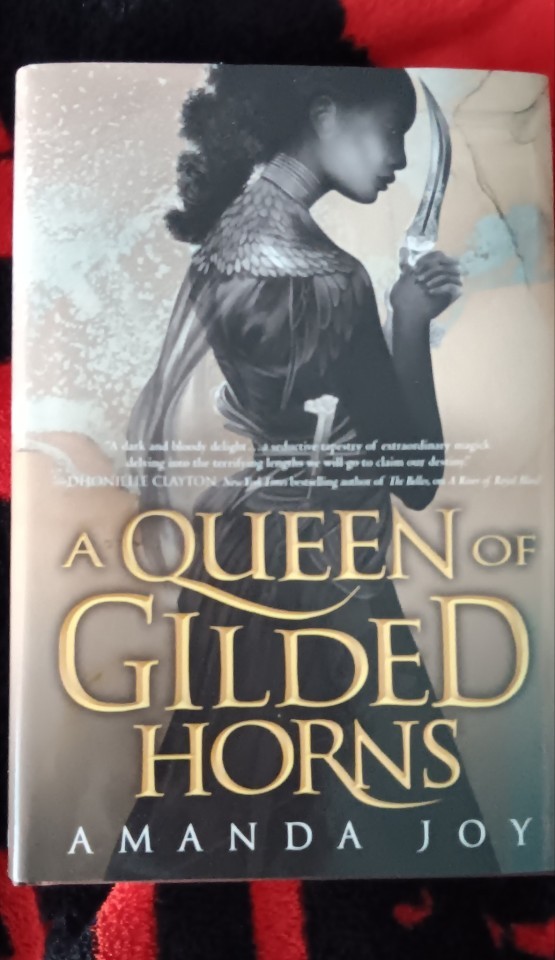
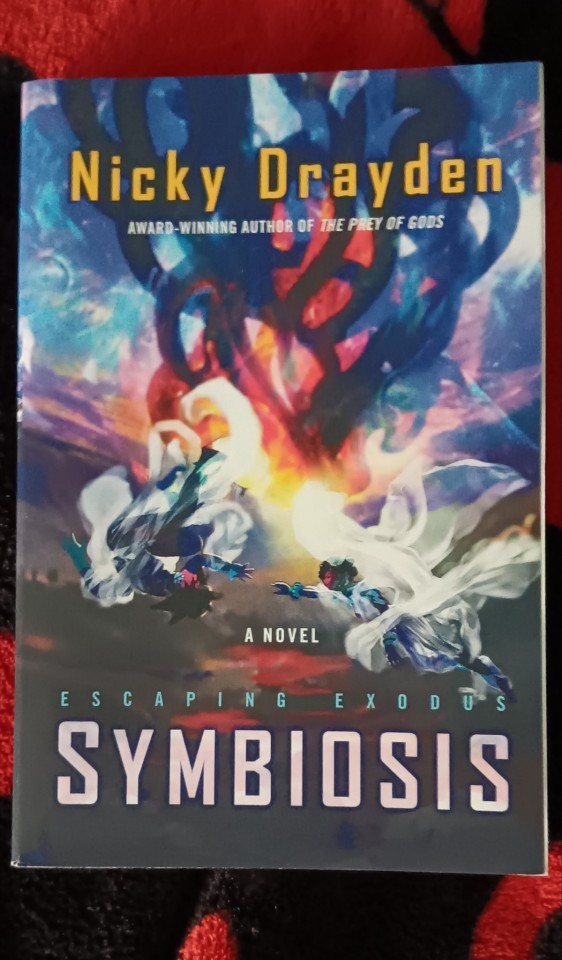
Legendborn(almost finished): black girl main character, interracial mf relationship, multiple queer supporting characters! YA fantasy with themes of racism and trauma
A Queen Of Gilded Horns(I've only read River of Royal Blood): Black main characters, black mf relationship, romance isn't the main plot which makes it very engaging for a romance tired black person like me! Focus is on racism in the fantasy world, multiple queer supporting characters!
Symbiosis (I haven't read Escaping Exodus yet): Black girl Mc, Sapphic relationship I heard! Mostly sci-fi plot I think! I'll recc it anyway cause I am gonna read it during this Black history month!
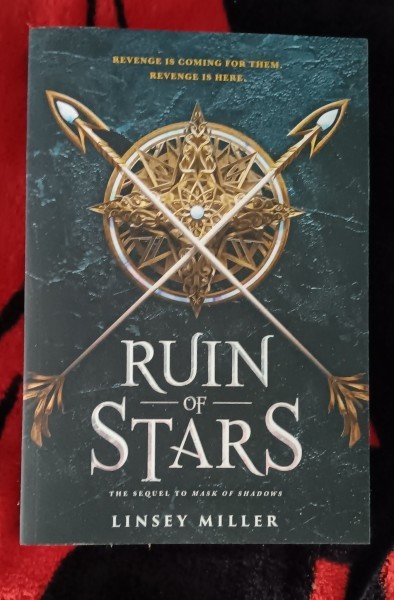
Ruin of Stars (only read Mask of Shadows): poc gender fluid main character in relationship with a woman, aromantic and black supporting character!! Fantasy with assassins and political commentary and trauma
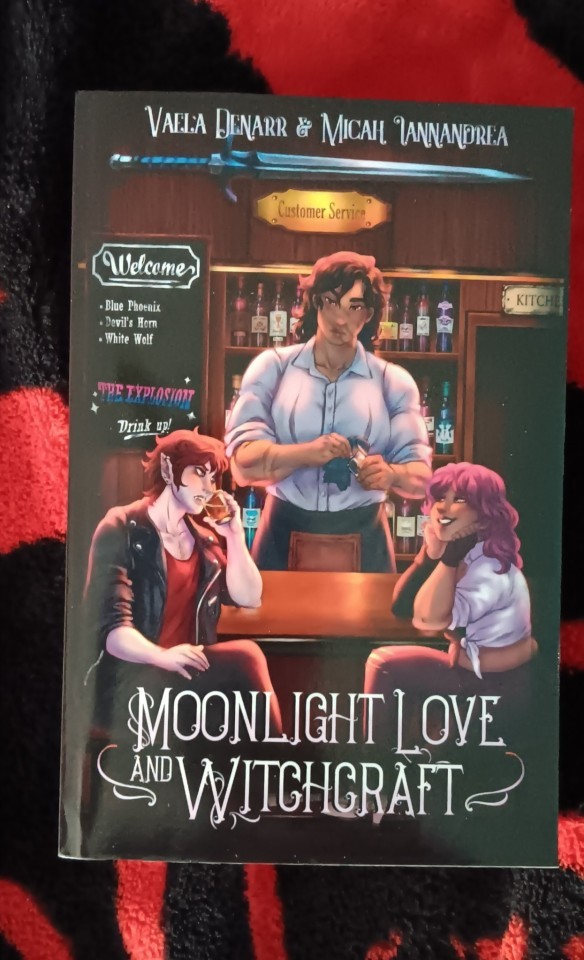
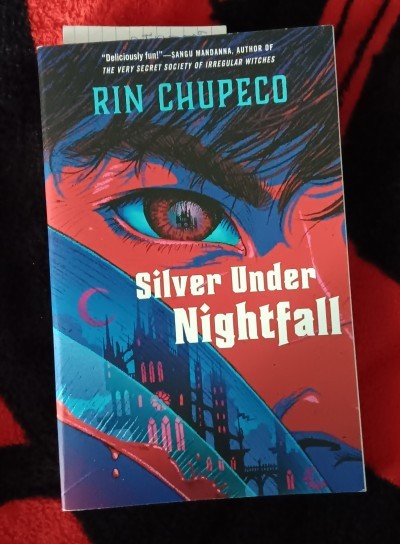

Moonlight Love Witchcraft(havent started): Multiple Poc Mcs, polyam relationship, nonbinary main character, asexual werewolf mc!! Indigenous mc!! Comfy fantasy!
Silver Under Nightfall(haven't finished): Black Mc alongside Asian Mc and genderfluid southeast asian??? mc!! Polyamorous relationship! Paranormal vampire fantasy with great plot!! So far!! Tw for SA and trauma
Blasted Research(haven't finished): ace and nonbinary mc!! Polyam m/nby/nby relationship! Dystopia sci-fi and only on ebook!
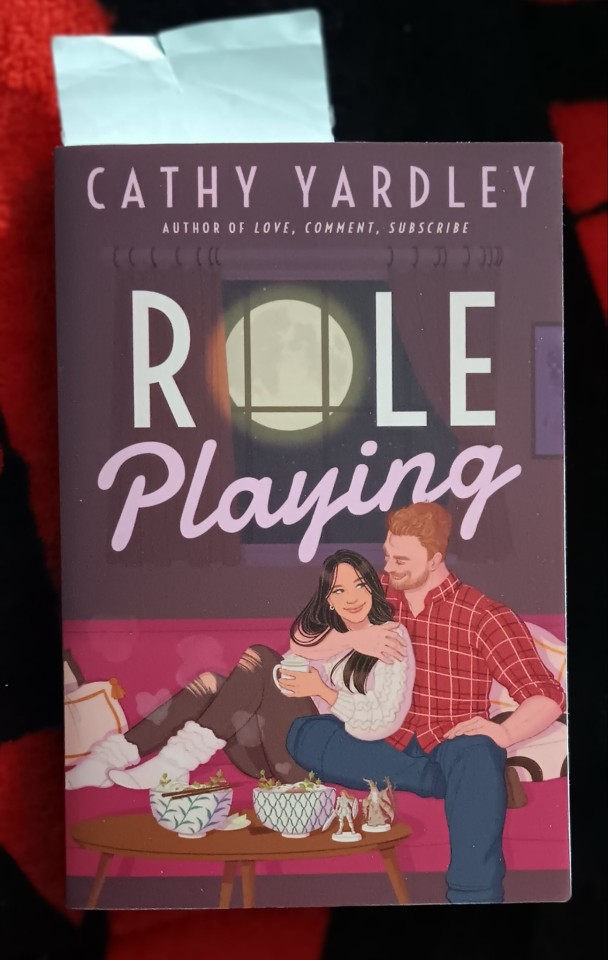

Role Playing(almost finished): Asian American mc and bi demirose mc! Mf relationship but queer!! Video game romcom with themes about the harms of amatonormativity featuring 50 year olds!
The Bone Season(haven't really started): Multiple poc supporting characters, main character is demirose! Multiple queer characters! Fantasy dystopian setting! Love interest is nonbinary??? In second book.
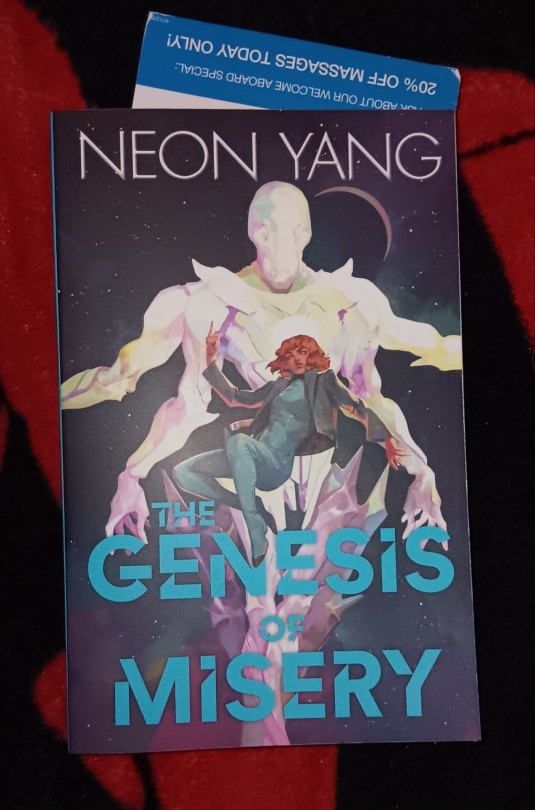

Genesis of Misery(haven't finished): nonbinary southeast asian mc! Sapphic relationship! Religious political sci-fi plot with multiple queer and poc characters!
Most Ardently(haven't finished): trans and queer retelling of Pride and Prejudice! Gay relationship! Plain historical romance! Multiple queer supporting characters!
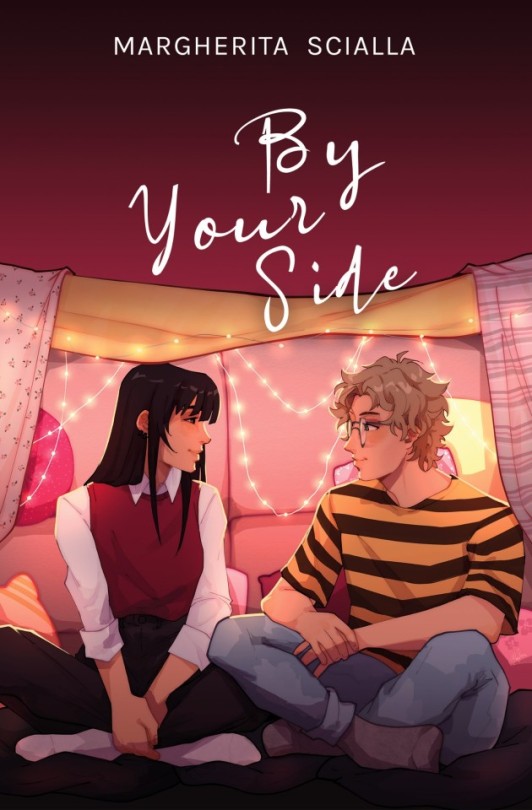
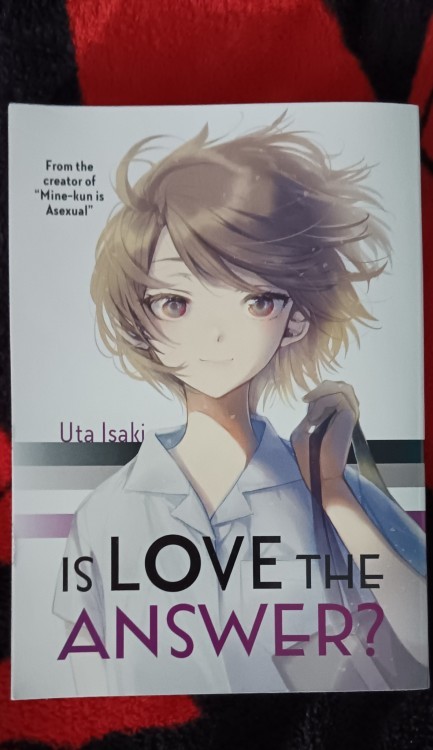
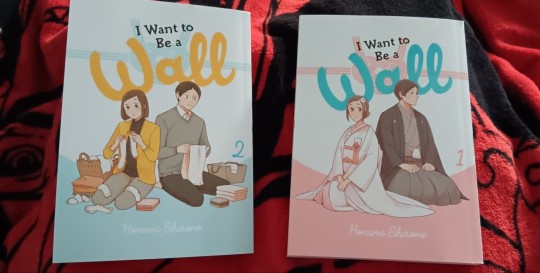
By Your Side(finished): a short queerplatonic story! Bi mc with aro mc! Polyam queerplatonic relationship!! Realistic college fiction that's like 38 pages!
Is Love the Answer (finished): aroace nonbinary mc and multiple aspec mcs! All poc cause they're Japanese. Possible queerplatonic relationships discussed! Realistic college fiction!
I Want To Be A Wall(finished): Japanese Aroace mc and gay mc married in a qpr!! Realistic comedic fiction! Full review here
If the authors have anything to add, I'll @ them here! @linseymiller @sshannonauthor @whatnowrin @coffeequills @thegabecole @themargherita-s @queerio-cheerios @itsneonyang
I also do art commissions if anyone would like to help me buy more queer and poc books 😢 😭
#aromantic#Valentine's Day#Arospec#Aspec#Asexual#Aro#Black History Month#Black Girl Magic#Booklr#Polyam#Polyamory#Polyam Pride#nonbinary#Canon Aspec#Black Tumblr#Demiromantic#Demisexual#Commissions Open#Valentines Day#Queerplatonic
50 notes
·
View notes
Text

Hello!! I'm Maddie and I am the creator of the Queer, Adopted, Asian American (aka Q-A-A-A) Zine.
A little history about Q-A-A-A: I first created this for my WGS senior seminar class with my own experiences as a queer, adopted, vietnamese person. I wanted to extend this to others who also identify like me, so here the tumblr be! Sooo, technically this is vol. 2 as the one I did myself is vol. 1
This collaborative zine is open to any artist or writer who identifies as Queer, Adopted, and Asian American. Also, there is no skill level required, I want to see everyone's works, so don't be shy at all! Sign ups will close August 1st. I do ask for a portfolio, so please be ready to submit 3-5 works in the style that you would like to see in the zine.
My ask is open for any questions, and I'm also working on a FAQ page.
Hope to collab with ya! 🫶🫶
SIGN UP HERE!
#zine#queer#asian#adopted#calling all artists#calling all writers#lgbtq community#artists on tumblr#zine promo#art zine#writing zine#bisexual#transgender#wlw#gay#lesbian
29 notes
·
View notes